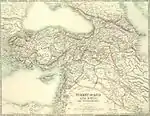Kadi Burhan al-Din
Qāżi Aḥmad Burhan al-Din (Turkish: Kadı Burhâneddin, 8 January 1345 – c. 1398; Azerbaijani: Qazi Bürhanəddin)[1] was vizier to the Eretnid rulers of Anatolia. In 1381 he took over Eretnid lands and claimed the title of sultan for himself. He is most often referred to by the title Qadi, a name for Islamic judges, which was his first occupation.
| Burhan al-Din | |
|---|---|
| Qadi | |
| Ruler of the Eretnids | |
| Reign | c. 1381 − c. 1398[1] |
| Born | 8 January 1345 Kayseri |
| Died | c. 1398 (aged 52–53) Erzincan |
| Father | Şemseddin Muhammed[1] |
| Mother | Unknown |
| Religion | Sunni Islam |
| History of Turkey |
|---|
 |
| Timeline |
|
|
Origin and early career
Burhan al-Din was born on 8 January 1345 in Kayseri. His father, Muhammad Shams al-Din, like his grandfather and great-grandfather, was a kadi, descended from the Oghuz Turkic tribe of Salur.[2] His father gave him his first education, which he furthered in Egypt, Damascus, and Aleppo. When he returned to his hometown in 1364/65, one year after his father's death, the local ruler, the Eretnid Giyath al-Din Muhammad, so esteemed his education and character that he gave the young man not only the post of kadi, but also the hand of his daughter.[2]
Despite this unusual favour, Burhan al-Din secretly participated in the rebellion of the local magnates (beys) in which Giyath al-Din was killed in 1365.[2] The latter's successors were incompetent, and Burhan al-Din rose further to the posts of vizier and atabeg, before proclaiming himself as the sovereign sultan of the Eretnid domains in 1381/82, establishing his residence at Sivas.[2]
Reign
The Eretnid sultanate Burhan al-Din inherited had a large Turkmen and Mongol population but also contained many of the older, established urban centers of the Seljuks of Rum and Ilkhanid Anatolia. The sultanate resembled these older states more than the Turkmen beyliks then ascendant in other parts of Anatolia.[3]
The Kadi's eighteen-year rule was not peaceful, being consumed with internal rebellions as well as conflicts with powerful neighbours, including the Karamanids and the emerging Ottoman Empire.[2] He challenged the Turkmen Karamanids and Beylik of Erzincan and twice fought Kötürüm Bayezid, the Jandarid bey of Kastamonu.
In 1387, Burhan al-Din was defeated by the Mamluks of Egypt, but soon allied with them against the Ak Koyunlu, only to later ally with the latter against rebellions of the beys of Amasya and Erzincan.[2] The Ottoman Sultan Bayezid I, accompanied by his vassal the Byzantine Emperor Manuel II Palaeologos, campaigned against Burhan al-Din in 1391, but was defeated at the Battle of Kırkdilim.[4]
When Burhan al-Din ordered the execution of the rebel governor of Kayseri, Sheikh Mu'ayyad, the Ak Koyunlu ruler Qara Osman turned against him. The Kadi was defeated, captured and executed by Qara Osman. Some sources give the date as July/August 1398, although other sources differ on the site and exact date, and his türbe (tomb) at Sivas bears no date.[2] His son Muhammad (d. 1391) and his daughter Habiba Seljuk-Khatun (d. 1446/7) are also buried there.[2]
Burhan al-Din was succeeded by his son Zayn al-‘Abidin, who ruled for a short time between 1398 and 1399.[5]
Poetry
He was an outstanding poet, who wrote in Turkish and Persian.[3] He played significant role in the development of the Azerbaijani poetry.[6][7] His diwan comprises 1,500 ghazals, 119 tuyughs, and a few distichs.[2] According to Jan Rypka, he was "a poet of profane love; mystical notes are sounded more rarely in his work".[2] Despite his ability, he was relatively unknown, and his work had little influence on later Azerbaijani or Ottoman poetry.[2] According to the Turkish scholar Mehmet Fuat Köprülü, Burhan al-Din's works "have all the peculiarities of the Azerbaijani dialect." Turkish historian and linguist Muharrem Ergin states that, despite being written in Anatolia, the works by Burhan al-Din fall within the realm of the Azerbaijani language due to their linguistic peculiarities.[8]
Burhan al-Din also composed two juridical works in Arabic, the Tardjīh al-tawḍīḥ in May 1397, and the Iksīr al-saʿādāt fī asrār al-ʿibādāt, which has remained in use until the present day.[2]
Biography
'Aziz ibn Ardashir Astarbadi, a companion of Kadi Burhan al-Din, wrote a Persian language history of his rule called Bazm-u Razm which was edited by M. F. Köprülüzade in 1928. An analysis and commentary has been provided by H. H. Giesecke, Das Werk des ‘Azīz ibn Ardašīr Astarābādi (Leipzig, 1940).
References
Citations
- Özaydın, Abdülkerim (2001). "Kadı Burhâneddin". TDV Encyclopedia of Islam, Vol. 24 (Kāânî-i Şîrâzî – Kastamonu) (in Turkish). Istanbul: Turkiye Diyanet Foundation, Centre for Islamic Studies. pp. 74–75. ISBN 978-975-389-451-7.
- Rypka, Jan (1960). "Burhãn al-Dīn". In Gibb, H. A. R.; Kramers, J. H.; Lévi-Provençal, E.; Schacht, J.; Lewis, B. & Pellat, Ch. (eds.). Encyclopaedia of Islam. Volume I: A–B (2nd ed.). Leiden: E. J. Brill. pp. 1327–1328. OCLC 495469456.
- Cahen, Claude (1968). Pre-Ottoman Turkey: A general survey of the material and spiritual culture and history, c. 1071–1330. New York: Taplinger. pp. 362–363.
- Elizabeth A. Zachariadou, "Manuel II Palaeologos on the Strife between Bāyezīd and Kādī Burhān Al-Dīn Ahmad" Bulletin of the School of Oriental and African Studies, Vol. 43, No. 3. (1980), p. 471.
- Stephen Album, A Checklist of Islamic Coins, 2nd ed. (1998), p. 114.
- electricpulp.com. "Azerbaijan x. Azeri Turkish Literature – Encyclopaedia Iranica". www.iranicaonline.org. Retrieved 23 April 2018.
- https://www.princeton.edu/~turkish/aatt/azeri.htm, American Association of Teachers of Turkic Languages
- Mustafayev 2013, p. 336.
Sources
- Mustafayev, Shahin (2013). "Ethnolinguistic Processes in the Turkic Milieu of Anatolia and Azerbaijan (14th–15th Centuries)". In Lascu, Stoica; Fetisleam, Melek (eds.). Contemporary Research in Turkology and Eurasian Studies: A Festschrift in Honor of Professor Tasin Gemil on the Occasion of His 70th Birthday. Cluj-Napoca: Cluj University Press. pp. 333–346. ISBN 978-973-595-622-6.
